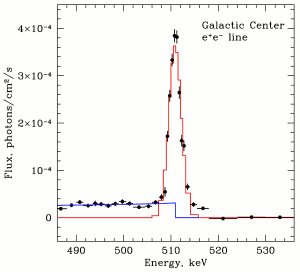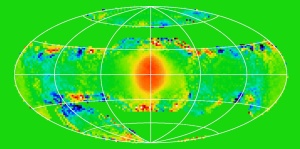 |
|
Fig. 1: Spectrum of the e+e- annihilation
radiation detected by SPI towards the GC region after 3.5 million
seconds exposure. The red line shows the positron annihilation line,
while blue line shows the continuum spectrum associated with the three
photon ortho-positronium decay.
|
 |
 |
|
Fig. 2: Heavily smoothed image of the Milky Way emission in the electron-positron
annihilation line. Central bright spot corresponds to the Galactic Center
region.
|
|  |
While great efforts have to be made for the production of sizable
quantities of antimatter in laboratories, some antiparticles,
especially the light ones, are routinely produced in nature. For
instance the so-called ß+ decay of radioactive isotopes leads to
the creation of a positron — a complete analog of the usual electron,
but with a positive charge. This happens for example during the
nuclear decay of the aluminium isotope Al26 into magnesium
Mg26. Positrons are produced in multitude inside the reactors of
usual nuclear power plants. In astrophysical conditions positrons can
as well be born during nuclear decay of radioactive elements, produced
in supernovae and nova explosions. They can also appear in the
vicinity of rapidly rotating neutron stars or black holes, be produced
by interaction of cosmic rays with ordinary matter or by gamma-ray
bursts. But the most fascinating is a possible link between positron
production and so-called "dark matter" particles. These dark matter
particles provide a very prominent contribution to the total mass of
the Universe, six times larger than the contribution of the ordinary
matter we are made of. Some versions of the modern theory allow such
particles to annihilate with each other, albeit very rarely, and to
give rise to positrons along with photons and other particles.
While there is no shortage in possible channels for positron
production, it remains to be determined which one is the most
important. Scientists at MPA use the INTEGRAL gamma-ray observatory to
search for signatures of positron production in our Galaxy. INTEGRAL
is a space project of the European Space Agency with participation of
Russia and USA, focused on imaging and ultra-fine spectroscopy in the
gamma-ray band of the electromagnetic spectrum. A collision of a
positron and an electron may result in the annihilation of the
particle and antiparticle and generation of a flash of gamma-ray
photons which INTEGRAL can detect. Particularly useful for positron
annihilation studies is the spectrometer SPI developped at CESR
(Toulouse) and MPE (Garching). In collaboration with Russian groups
large share of the INTEGRAL observing time was spent on observing the
Galactic Center region which is the most powerful source of the
annihilation radiation on the sky. As a result more than 200000
annihilations photons were accumulated by SPI during first year,
allowing for most accurate determination of the annihilation
spectrum. The analysis of various data sets obtained by INTEGRAL is
now going on in many scientific groups in Europe, Russia and USA.
In most scenarios positrons are born hot, i.e. their kinetic energy is
at least of the order of their rest mass. The cross section for
annihilation is very small and the positrons first cool down (lose
their kinetic energy) via collisions with particles of ordinary
matter. Once the energy of the positron decreases below 100 eV mutual
attraction of positrons and electrons starts to dominate and they form
so-called positronium atoms. Positronium is analogous to the hydrogen
atom with the proton replaced by a positron. Positronium is thus
composed of a particle and an antiparticle and so it lives less than
10-7 seconds before annihilating in a gamma-ray
flash. Positronium appears in two flavors: ortho and para-positronium,
with the former accounting for about 75% of all positronium atoms
and the latter making up the remaining 25%, but living only
10-10 seconds. Para-positronium annihilation produces two
photons with energy equal to the rest mass of the electron or the
positron — 511 keV, which can be observed by telescopes as a narrow
gamma-ray line. Ortho-positronium decays into 3 photons and instead of
a narrow line a broad continuum is observed. These are exactly the
signatures which INTEGRAL sees coming from the central region of the
Galaxy as shown in Fig.1. Based on data from the first year of
INTEGRAL operations, the position of the line center is found to
coincide with the rest energy of the electron or positron to an
accuracy better than one part out of 10000. Both the width of the line
and ratio of the fluxes in the narrow line and low energy continuum
are consistent with the annihilation of positrons in a warm (T ≈
8000K) slightly ionized gas which occupies a large volume in the
disk of the Galaxy.
Thus INTEGRAL observations do show that plenty of positrons are
annihilating in warm partly ionized matter in the Galaxy every
second. The question of the ultimate source of these positrons is yet
to be answered with ongoing INTEGRAL observations. A large fraction of
positrons are annihilating in the innermost region of the Galaxy. Type
I supernovae — the "standard" candidate for positrons production
could be the primary source, but to account for the bulk of the
Galactic positrons they have to escape from a dense supernova remnant.
Production of positrons by dark matter particles therefore remains an
attractive option. A crucial test would be provided by comparing the
exact morphology of the annihilation line intensity distribution with
the distribution of potential sources of positrons, including compact
sources, supernova remnants and dark matter. INTEGRAL is now making a
detailed map of annihilation radiation to finally resolve this
problem.
E. Churazov, R. Sunyaev, S. Sazonov, M. Revnivtsev
Further information:
E. Churazov, R. Sunyaev, S. Sazonov, M. Revnivtsev, D. Varshalovich,
Positron annihilation spectrum from the Galactic Centre region
observed by SPI/INTEGRAL, 2005, MNRAS, 357, 1377
INTEGRAL WEB page:
 http://www.rssd.esa.int/Integral http://www.rssd.esa.int/Integral
|



